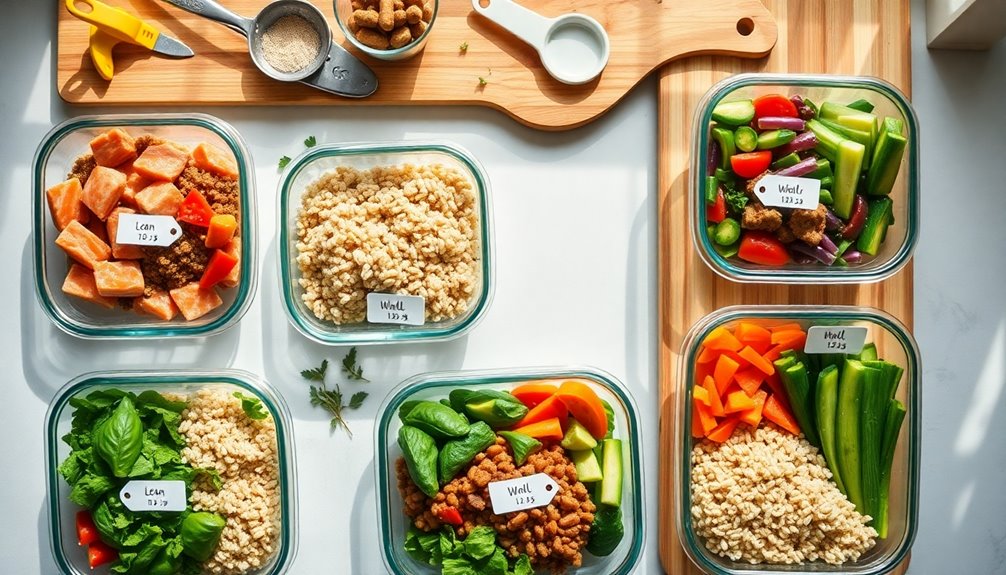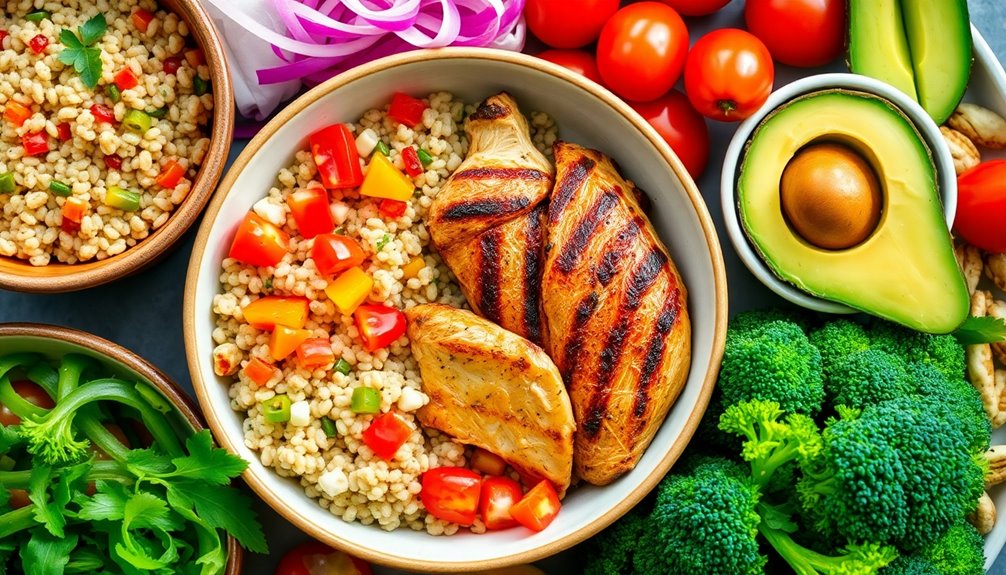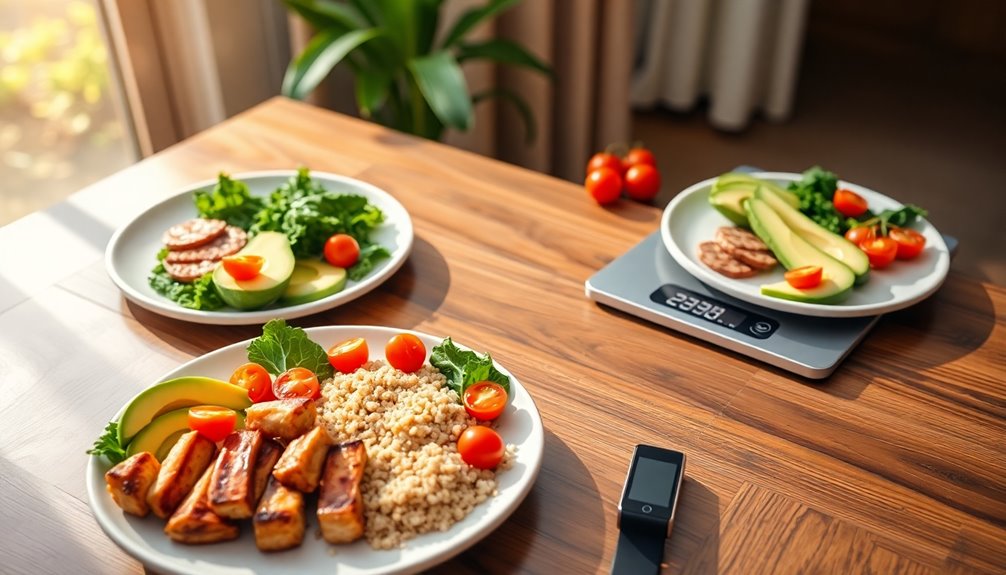To balance macronutrients in every meal, start by understanding their roles: carbs for energy, proteins for repair, and fats for hormones. Aim for an ideal ratio of 40% carbs, 30% protein, and 30% fats. Plan your meals using the Plate Method: fill half your plate with non-starchy veggies, a quarter with lean proteins, and a quarter with whole grains. Choose whole food sources and control portions with smaller plates. Don't forget to balance snacks, adjust based on your activity level, and experiment with different ratios. Stick around for more strategies to optimize your nutrition!
Key Takeaways
- Use the Plate Method: fill half your plate with non-starchy veggies, a quarter with lean proteins, and a quarter with whole grains or starchy veggies.
- Incorporate a variety of whole food sources, such as fresh fruits, whole grains, and healthy fats, to enhance nutrient diversity.
- Experiment with different macronutrient ratios to find what works best for your energy levels and performance.
- Plan meals with balanced snacks that include a mix of carbohydrates, proteins, and fats to maintain steady energy.
- Track your food intake to monitor macronutrient balance and make adjustments based on your activity levels and personal goals.
Understand Macronutrient Basics

Macronutrients are the foundation of your diet, made up of carbohydrates, proteins, and fats. Each plays a distinct role in your overall health, and understanding macronutrient basics can help you create well-rounded meals that nourish your body and support your lifestyle.
Carbohydrates are your body's primary energy source. They break down into glucose, fueling everything from your daily activities to intense workouts. Proteins, on the other hand, are essential for repair and growth. They help build and maintain muscle, support immune function, and produce hormones. Finally, fats are essential for hormone production and nutrient absorption, providing a concentrated source of energy.
To achieve ideal health, consider your macronutrient ratios. This refers to the proportion of carbohydrates, proteins, and fats in your diet. A common starting point is 40% carbs, 30% protein, and 30% fats, though individual needs may vary based on activity level, age, and health goals.
Nutrient distribution within your meals also matters. Aim for balanced plates that include all three macronutrients. For example, pair lean proteins with whole grains and healthy fats to create satisfying, nutrient-dense meals. Additionally, utilizing a custom keto diet plan can further optimize your macronutrient intake for better results.
Calculate Your Macronutrient Needs

To effectively customize your diet, it's crucial to determine your macronutrient needs based on your specific goals and lifestyle. Begin by calculating your total daily energy expenditure (TDEE), considering factors such as your age, weight, height, activity level, and overall health. There are several online calculators available to assist with this.
Once you have determined your TDEE, you should establish a caloric goal that aligns with your objectives—be it weight loss, maintenance, or muscle gain.
Subsequently, you'll define your macronutrient ratios. One common method is to divide your daily intake into proportions; for example, 40% carbohydrates, 30% protein, and 30% fats. Nevertheless, these proportions may differ depending on your specific requirements. For instance, athletes might need increased protein levels for muscle recovery.
After setting your ratios, convert these proportions into grams. Given that there are 4 calories per gram of protein and carbohydrates, and 9 calories per gram of fat, you can readily determine the appropriate grams of each macronutrient to target in your daily consumption. Additionally, incorporating a plant-based diet can help you meet your macronutrient needs while also promoting overall health and environmental sustainability.
Plan Your Meals Ahead

Here is the revised content with the new sentence added:
Having established your macronutrient needs, the next step is to plan your meals ahead. Meal prep is key to ensuring you consistently hit your targets while enjoying balanced combinations of proteins, fats, and carbohydrates. Planning not only saves time but also helps you avoid the temptation of unhealthy choices when you're hungry.
Here are some practical tips to make meal prep easier:
- Create a weekly menu: Outline your meals for each day, focusing on varied ingredients.
- Batch cook: Prepare larger quantities of staple items like grains, proteins, and vegetables, so you can mix and match throughout the week.
- Use portion containers: Invest in some containers to keep your meals organized and visually appealing.
- Incorporate snacks: Don't forget to plan for healthy snacks that complement your macronutrient goals.
- Stay flexible: Life can be unpredictable, so leave room for adjustment while still keeping your nutritional needs in mind. Additionally, following a plan like Half Day Keto can help optimize your macronutrient balance while still allowing for some carbohydrate intake.
Use the Plate Method

Using the Plate Method can simplify your approach to balancing macronutrients at every meal. This practical strategy helps you create balanced meals by visually dividing your plate into sections. By doing so, you can ensure you're obtaining the correct proportions of carbohydrates, proteins, and fats.
To use the Plate Method effectively, start by filling half your plate with non-starchy vegetables. This not only adds essential vitamins and minerals but also promotes portion control, helping you feel full without excessive calories.
Next, dedicate one quarter of your plate to lean protein sources, such as chicken, fish, or plant-based proteins like beans or lentils. This is vital for muscle repair and energy.
Finally, use the remaining quarter for whole grains or starchy vegetables, like brown rice or sweet potatoes, which provide the carbohydrates your body needs for fuel. Incorporating plant-based proteins into your meals can enhance your overall health and well-being.
By following this simple visual guide, you can create meals that aren't only balanced but also satisfying. The Plate Method encourages you to think about your food choices and promotes a sense of community around shared meals. You'll find that this method can make it easier to stick to healthier eating patterns, as it's adaptable to various cuisines and preferences.
Incorporating the Plate Method into your daily routine can lead to more mindful eating. It helps you establish a foundation for balanced meals, making it easier to maintain your health and well-being. Plus, it fosters a greater connection with your food and those you share it with.
Choose Whole Food Sources

Choosing whole food sources is another key step in balancing macronutrients effectively. When you prioritize whole foods, you're not just feeding your body; you're nourishing it with nutrient-dense choices that help create balanced plates. These foods are less processed and typically offer more vitamins, minerals, and fiber, which are essential for peak health.
To help you embrace whole food sources, consider these tips:
- Go for fresh fruits and vegetables: They're packed with nutrients and fiber-rich options that support digestion.
- Select whole grains: Brown rice, quinoa, and oats provide sustained energy and are great for meal prep.
- Incorporate lean proteins: Chicken, fish, beans, and legumes are excellent choices for building muscle and maintaining energy levels.
- Include healthy fats: Avocados, nuts, and olive oil can enhance flavor while providing essential fatty acids.
- Limit processed foods: These often contain added sugars, unhealthy fats, and preservatives that can disrupt your macronutrient balance.
- Consider adding homemade smoothies that are packed with plant-based protein to boost your nutrient intake while keeping added sugars at bay.
Incorporate Variety in Diet

Incorporating variety into your diet isn't just about keeping meals interesting; it's essential for ensuring you receive a broad spectrum of nutrients. When you mix different food groups, you're not only enhancing the nutritional value of your meals but also discovering new flavor profiles that can make eating a joy. Aim for a colorful plate—each hue often represents different vitamins and minerals.
Experimenting with flavorful combinations can elevate your meals from mundane to memorable. For instance, consider adding berries to a spinach salad, or mixing quinoa with roasted vegetables and a squeeze of lemon. These combinations not only taste great but also provide a range of nutrients essential for your well-being. Additionally, incorporating low-carb, anti-inflammatory foods can further enhance your meal's health benefits.
Culinary creativity can be your best ally in this journey. Trying new recipes or different cooking methods can introduce you to foods you mightn't have considered. Don't shy away from exploring international cuisines; they often provide unique ingredients and preparation techniques that keep your palate excited.
Consider setting a weekly theme: Meatless Mondays or Taco Tuesdays can encourage you to explore various ingredients while ensuring you balance your macronutrients. Remember, it's about making small, manageable changes that lead to a more diverse diet.
Pay Attention to Portion Sizes

Even with a varied diet, how you manage your portion sizes can significantly impact your overall health. Practicing portion control is essential for maintaining a balanced intake of macronutrients, and it can help prevent overeating. Mindful eating is another key component, as it encourages you to pay attention to what and how much you consume. Here are some practical tips to get you started:
- Use smaller plates to create the illusion of a fuller plate.
- Measure servings when trying new recipes to understand portion sizes better.
- Listen to your body's hunger cues – eat when you're hungry, not out of boredom.
- Avoid distractions while eating; focus on your meal to enhance satisfaction.
- Practice moderation by enjoying your favorite foods in smaller amounts.
By being mindful of portion sizes, you can create a more balanced plate that meets your nutritional needs without going overboard. Start by evaluating the current portions you're serving yourself. Are they larger than necessary? Reducing portions can lead to better satiety and a more satisfying experience. Additionally, incorporating variety in Keto breakfasts can help prevent meal monotony and support your macronutrient balance.
Incorporating these habits into your daily routine not only supports your health goals but fosters a sense of community with others who are also working towards balance. Remember, it's not just about what you eat; it's about how much you eat and being present during your meals. Embrace the journey to a healthier you through conscious choices and mindful eating.
Balance Macronutrients in Snacks

While snacks can often be overlooked in the quest for balanced nutrition, they play an important role in maintaining energy levels and curbing hunger between meals. By focusing on nutrient balance in your snacks, you can support your overall health and stay energized throughout the day.
When choosing snack options, aim for a combination of macronutrients: carbohydrates, proteins, and fats. For instance, pairing apple slices with almond butter offers you the natural sugars from the apples, healthy fats from the almond butter, and a bit of protein. This combination not only satisfies your taste buds but also keeps you fuller for longer.
Another great option is Greek yogurt topped with berries and a sprinkle of granola. The yogurt provides protein, the berries add fiber and antioxidants, and the granola contributes healthy carbohydrates. This snack isn't only delicious but also helps maintain that essential nutrient balance.
If you're looking for something savory, consider whole-grain crackers with hummus. The crackers deliver complex carbohydrates, while the hummus provides plant-based protein and healthy fats. Incorporating snacks that follow natural calorie cycles can further enhance your energy levels and overall well-being.
Adjust Based on Activity Level

Adjusting your macronutrient intake based on your activity level is crucial to optimizing your energy and performance throughout the day. Whether you're hitting the gym, enjoying a leisurely walk, or tackling a busy workday, your nutritional needs shift accordingly. Here are some practical tips to help you adjust:
- Increase protein intake on workout days for muscle repair.
- Incorporate carb cycling by varying your carbohydrate consumption to match your training schedule.
- Focus on protein timing by consuming protein-rich meals or snacks shortly after your workouts.
- Stay hydrated, as hydration needs can fluctuate with activity levels.
- Listen to your body—adjust portions based on how you feel during workouts and daily activities.
When you engage in high-intensity activities, your body necessitates more carbohydrates for quick energy. On rest days, consider reducing your carb intake while maintaining adequate protein to support muscle recovery. Additionally, be mindful that consuming traditional bread can have negative impacts on blood sugar spikes, which could affect your energy levels.
Carb cycling, which involves alternating between high and low carb days, can be particularly effective for those looking to improve body composition without sacrificing performance.
Don't overlook protein timing; consuming protein soon after exercise supports muscle recovery and growth. This safeguards that your body gets the nutrients it needs when it's most effective.
Experiment and Track Progress

As you embark on your journey to balance macronutrients in every meal, experimenting with different ratios can unveil what works best for your body. Everyone's needs are unique, so customizing your meals based on how you feel and perform is crucial. Utilize tracking tools like apps or journals to monitor your macronutrient intake, energy levels, and overall well-being. This data will assist you in adjusting your approach effectively.
Begin by experimenting with recipes that integrate various combinations of proteins, carbohydrates, and fats. You might discover that a 40/30/30 split works wonders one week, while a 30/40/30 ratio feels better the next. Here's a simple table to assist you in your experiments:
| Meal Type | Macronutrient Ratio | Example Recipe |
|---|---|---|
| Breakfast | 30/40/30 | Greek yogurt with fruit and nuts |
| Lunch | 40/30/30 | Quinoa salad with chicken and veggies |
| Dinner | 30/30/40 | Salmon with brown rice and asparagus |
Monitoring your progress will help you pinpoint patterns and preferences. After a few weeks, review your notes. Are there specific ratios that consistently result in better energy levels or satisfaction? Embrace the process of trial and error; it's a part of developing a sustainable and enjoyable eating plan. Additionally, incorporating mini bands for body sculpting can complement your nutritional goals by enhancing muscle tone and strength. Remember, you're not alone in this journey—share your findings with a community or friends who have similar goals.
Frequently Asked Questions
Can I Balance Macronutrients on a Vegetarian or Vegan Diet?
Yes, you can absolutely balance macronutrients on a vegetarian or vegan diet! Focus on incorporating plant-based protein sources like lentils, chickpeas, and quinoa to meet your protein needs.
Don't forget about healthy fats from nuts and avocados. For an easy nutrient boost, whip up macronutrient-rich smoothies using spinach, bananas, and nut butter.
This way, you'll enjoy a well-rounded diet while feeling empowered in your food choices.
How Do Food Intolerances Affect Macronutrient Balance?
Think of your diet as a finely tuned orchestra. When food intolerances strike, they can create disharmony. Allergies impact your ability to enjoy certain foods, which can lead to digestive issues and an overall macronutrient imbalance.
You might find it challenging to get enough protein or healthy fats, depending on what you can't eat. Adjusting your meals mindfully guarantees you still hit those nutritional notes, fostering a sense of belonging in your dietary journey.
What Are the Best Macronutrient Ratios for Weight Loss?
When it comes to weight loss, a common macronutrient ratio is 40% carbohydrates, 30% protein, and 30% fats. But it's essential you consider proper portion sizes and timing meals for best results. Eating smaller, balanced meals throughout the day can keep your metabolism active and prevent cravings.
Experiment with these ratios to find what works best for you, as individual needs can vary. You're on a journey, and finding balance is key!
How Can I Balance Macronutrients While Dining Out?
When you're dining out, balancing macronutrients can be simple. Look for plant-based options, as they often provide fiber and essential nutrients.
Don't hesitate to customize meals by asking for extra veggies or swapping out sides. Many restaurants offer protein choices like beans or tofu that fit your needs.
Are There Specific Supplements to Help With Macronutrient Balance?
When it comes to supplements for macronutrient balance, consider protein powders, omega-3 fatty acids, and branched-chain amino acids (BCAAs). These can enhance nutrient absorption and support your overall health.
Always choose high-quality products that fit your dietary needs.
It's vital to consult a healthcare professional before starting any new supplement regimen.
Conclusion
Balancing macronutrients at every meal can greatly enhance your overall health and energy levels. For example, imagine a busy professional, Lisa, who incorporates lean protein, healthy fats, and complex carbs into her lunch. By choosing grilled chicken with quinoa and avocado, she feels more energized and focused throughout the afternoon. By tracking her meals and adjusting based on her activity, she finds the perfect balance that fuels her lifestyle. Start today, and you'll notice the difference!



